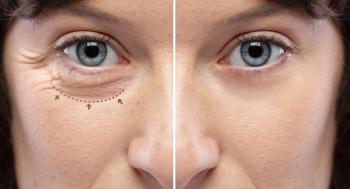
CCS 2025: Managing laser corneal refractive surgery and implantable collamer lens based procedures
Key Takeaways
- The EVO ICL, with its central hole, improves safety and expands patient eligibility, increasing its prevalence in refractive surgery.
- Effective collaborative care requires thorough pre- and postoperative management, patient education, and strong communication between surgeons and optometrists.
Video Transcript:
Editor's note: The below transcript has been lightly edited for clarity.
Sheryl Stevenson:
We're joined today by Dr Jason Brenner, who is among the faculty at this year's Collaborative Care Symposium, which is going to be held virtually May 30 and 31. So welcome to you. I know you're going to be speaking alongside Dr Vivian Yao, and the topic of your session is related to managing laser corneal refractive surgery and implantable collamer lens-based procedures. But can you tell us a little bit about your talk? What are some of the key highlights that you expect to be talking about?
Jason Brenner, MD:
Sure, so we wanted to focus on kind of the clinical management of patients, both pre-op and post-op, when it comes to refractive surgery. And you know, that's something that's constantly evolving with new technology and new options. And so we wanted to sort of update things like the new version of the implantable contact lens and SMILE and different kinds of LASIK that are happening, and then how to sort of manage these patients post-op in a sort of collaborative care environment. And what to look for, and when you need to help decide when you need to send that patient back to get another look from the person who did the surgery. So, you know, we have some cases in it, and we just think it'll be a very practical review of these things.
Sheryl Stevenson:
So let's, I guess, kind of take it from the top, then a little bit, and talk a little bit about the recent advances in these technologies. What are some things that clinicians should be aware of or know about?
Jason Brenner, MD:
I think the big one is ICL. I think ICL with the new version called EVO, which what the lens changed, is that there's a little hole in the center of the lens. And it doesn't sound like a big deal, but it's a big deal in terms of safety and how we manage these patients. And has really allowed us to expand who we offer ICL to, because the safety profile is so much better than it used to be. And so because of that, you know, I think there's a lot more patients getting ICL, both in the US and around the world. And so where they used to be pretty rare, and people probably would go a lot of time without encountering a patient that has ICL. I think now people are going to start encountering this on a relatively routine basis. And in our practice, over 20% of patients coming in for surgery are getting an ICL now. So, you know, between the world getting more myopic and having this option out there, I think it's a good thing for people to to get a refresher on.
Sheryl Stevenson:
Sure, absolutely. And I guess you know, what are some strategies in the spirit of collaborative care? You know, what are some strategies for managing patient expectations before surgery? You know whether you're collaborating with a referring optometrist or they come to you. What are some pearls for managing their expectations?
Jason Brenner, MD:
So you know, one of the things is that LASIK still has amazing brand recognition, and everyone knows what LASIK is. But they may not know, you know, PRK; they may not know SMILE surgery, which we'll talk about, or the ICL, or even that, you know, it's an option to do cataract surgery early as a refractive lens exchange. So our toolkit has widened a lot, and it's very helpful. I think when you're talking to a patient about going to get evaluated for surgery, it's just to kind of plant that seed in their mind that maybe, you know, the practice may talk about something else other than just LASIK. And you know, knowing when someone is a good candidate for one procedure versus the other is very helpful to start to educate your own patients before you send them. So that's kind of one of our goals, is just to talk about how our thought process has changed on what options to pick for surgery. And then, certainly postoperatively, you know, ICL is very different than laser vision correction. So we wanted to talk about how these lenses affect astigmatism and what vault is, and how to judge vault and and what happens with these patients over time, and what's the next step in their vision journey years down the road. So, you know, we're going to touch on those topics.
Sheryl Stevenson:
You mentioned, that's a good point too, like postoperatively, you know, what are the ideal follow-up protocols, you know, for collaborative care, and where do you see, maybe, improvement in coordination?
Jason Brenner, MD:
So, you know, ICL follow-up is, you know, it's a typical time frame as LASIK, where most people do 1 day, 1 week, 6week. And we're really judging their vault throughout that time—how the ICL is sitting in their eye. And we want to look for rotation and astigmatism management, because that's a little bit different than laser vision correction. It's something that can change over time. And then also, because there is that little magic hole in the center of the lens, patients may see some glare and halo for a period of time. So how to talk to patients about that. And then what to do if all of their refractive error is not corrected by the ICL, and what their options are from there. And then further down the road, we want to make sure we watch these patients for glaucoma and cataracts and things that are rare but are still risks of ICL surgery. So I always tell our ICL patients, just because you see well doesn't mean you can stop going to the eye doctor. And these are things that everyone needs to work together as a team to follow these patients and manage over time.
Sheryl Stevenson:
Absolutely, and in your experience, you know, what factors contribute to successful long-term outcomes in comanagement of refractive surgery patients?
Jason Brenner, MD:
I think most importantly, is communication between the surgeon and the optometric group so that we know where the patient has been. What have they been doing with glasses or contacts? What is their lifestyle like? How do they use their eyes? What's their dry eye status over time? Is their dry eye only contact lens induced? Is it all the time they have dry eye? And really, what appeals to them about surgery? So these things coming in—if the patient comes in with that kind of knowledge or that is communicated to us somehow, it really helps us make a decision for the patient, because we're meeting them one time for, you know, maybe 30 minutes at the time they get to spend with their surgeon. Versus, you know, an optometrist who may have been with a patient for decades. So the more information we get, the better. And then postoperatively, same thing. I think, you know, I like to give my cell phone to not only all my patients but also all the doctors that refer to me so that if you have a quick question about something, we can communicate easily. And I think that's an important part of the collaborative care, because we don't want the surgical group and the post-op group to be operating on two separate islands and not know what's going on with each other.
Sheryl Stevenson:
Yeah, and perfectly, you kind of segued right into my next question, actually. So with collaborative care in the name of the meeting, what can eye care providers, how can we learn from each other? What is the benefit of it?
Jason Brenner, MD:
We want to know how patients are doing postoperatively, and I think that's really important to change how we manage patients in the future. And if we send the patient out and we don't know how they're doing. How is their refractive error? How's their dry eye? How's glare and halo? What happened with presbyopia? Was the lens implant stable? Was their laser treatment stable? All these things we really need to know to do a better job in the future. And so not only just managing that patient and what happens with their eye, but the whole big picture of what happens with refractive surgery, I think the more postop data that we get from people, both positive and negative, is useful to know.
Sheryl Stevenson:
Lastly, what are the key takeaways that you really hope people take back to their clinic come Monday morning?
Jason Brenner, MD:
I think that we really want people to know some of the key things to check for in the first postoperative week, which is the key time for a lot of surgeries where, you know, we watch out for bad things. Specifically with laser vision correction, we're looking for inflammation like DLK. And for ICL we want to look at vault and positioning of the lens and watch for signs of infection and pressure. And so, you know, we really want to nail down what those key one-week findings are how to look out for patients that could be in trouble. And then I think we want to really focus on the long term, what happens with these patients afterwards, and how to communicate their long-term result with us. So that we're not just looking at a brief period of time in a patient's vision journey. Another thing we're going to touch base on is office-based surgery, which is a growing trend in ophthalmology, especially with ICLs. And what office-based surgery means, and the difference between an ambulatory surgery center or hospital setting. The positives, negatives, the clinical side of it, how they get certified, as well as the financial and insurance side of it. Because that's an important change that's happening across the country in terms of surgical care, and so it really does apply when we're talking about refractive surgery also.
Newsletter
Don’t miss out—get Ophthalmology Times updates on the latest clinical advancements and expert interviews, straight to your inbox.













































.png)


